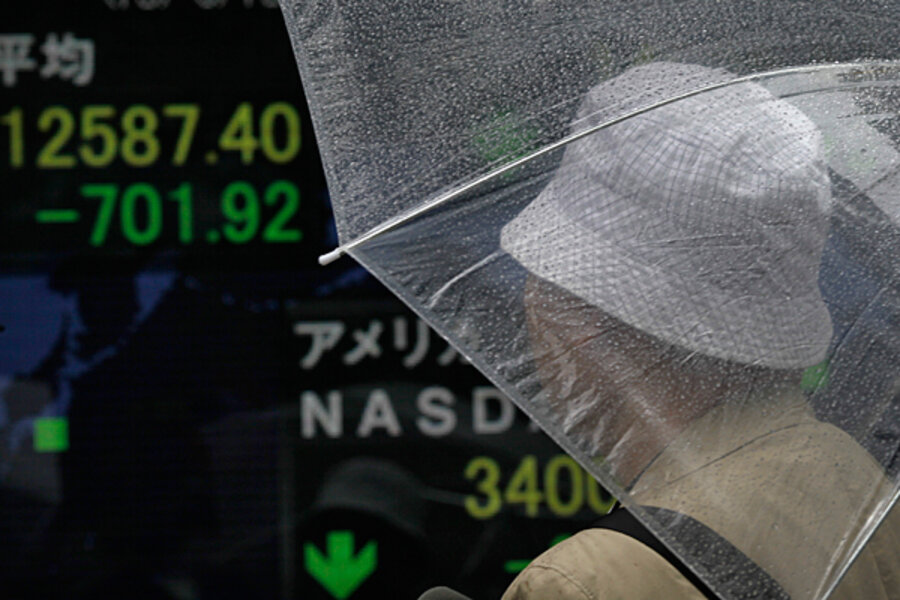Dow up, Nikkei down: Days of market volatility put focus on central banks
Loading...
Global stock markets are shaky. Bonds no longer look like a safe haven.
That’s been the unsettling message from financial markets in recent days. On Thursday, the US stock market offered a respite – rising more than 1 percent despite larger declines by markets in Asia earlier in the day.
But what does all the volatility – coming just weeks after a period of Dow 15000 elation – mean?
It’s a sign of investor unease more than of panic. The US economy, the world’s largest, is expected to keep growing, but not very fast. Much of Europe is in recession, with still-simmering sovereign-debt challenges to navigate. Investor faith in Japan’s monetary stimulus, designed to revive economic growth, has wavered.
And emerging-market nations aren’t immune from some spillover effects. China recently reported slower-than-expected export growth.
In all, the picture is of a global economy struggling to develop self-sustaining momentum and stability, some five years after a financial crisis.
“A perceived peak in global central bank stimulus has coincided with a near-term top in global equity prices,” Sam Stovall, chief equity strategist at Standard & Poor’s, wrote in a note to clients this week. He sees a dip or “correction” of up to 10 percent in US stock prices as possible, but said the likeliest scenarios call for “even higher highs before the year is out.”
The road ahead may be uncertain, but the rise in US stocks Thursday reflected optimism that the Federal Reserve will use a meeting next week to dampen concerns that it might allow short-term interest rates to rise.
The Dow Jones Industrial Average rose 1.2 percent Thursday (closing at 15176.08), after declines in key European markets and a drop of more than 6 percent for Japan’s Nikkei index.
A key theme connecting much of the market volatility in recent days appears to be that financial markets remain heavily influenced by the policies – and potential policy shifts – of central banks.
Japan’s main stock index is down 15 percent since late May amid investor doubts about a new monetary stimulus program, for example.
In the US, with the economy on sounder footing, the stock price dip since late-May peaks hasn’t been nearly as big.
But uncertainty about central bank policy has taken a different form. US bond prices have been falling, in part on the theory that an improving economy will – perhaps sooner rather than later – cause the Federal Reserve to scale back its own stimulus efforts.
Recent declines in bond prices may be partly a good thing: It’s normal that a strengthening economy would see interest rates rise (and bond prices inversely down) from crisis-induced lows.
But rising interest rates make it more costly for firms and individuals to borrow. The US economy still isn’t roaring ahead on all cylinders. And turmoil in the bond market isn’t easy on investors.
The Federal Reserve is currently engaged in a third round of a bond-buying stimulus program, known as quantitative easing (QE).
“Fears that the tapering of QE3 will mark the start of a prolonged bear market for equities are probably overdone,” writes Julian Jessop, chief global economist at Capital Economics.
While some market analysts say a long bull market in bonds is over, Mr. Jessop says it’s not clear that a phasing out of QE will be terrible for bond prices. Moreover, phasing out QE would be separate from any Fed decision to raise the short-term interest rate that it sets for lending by banks to one another.
Europe-focused investors have their own questions about monetary policy. Some economists say the European Central Bank hasn’t been doing enough to get bank credit flowing.
And, like the US and Japan, the advanced economies in Europe face challenges with high and rising levels of government debt.
In a press briefing last week, European Central Bank chief Mario Draghi warned governments not to “get too optimistic” or complacent about stable market conditions. He called for a continued push to address budget imbalances and to enact pro-growth economic policies such as labor-market reforms.
“You cannot have growth with endless debt creation,” he said.






